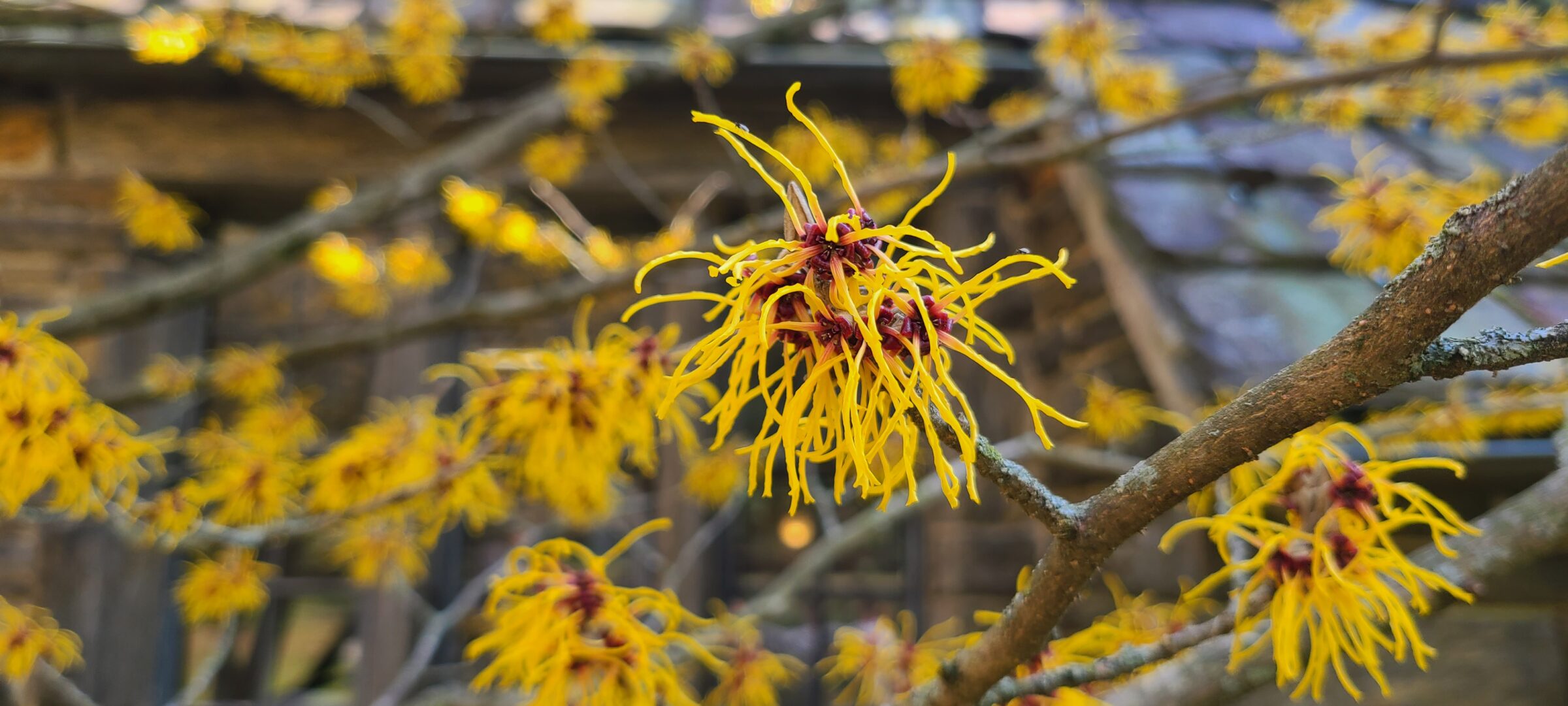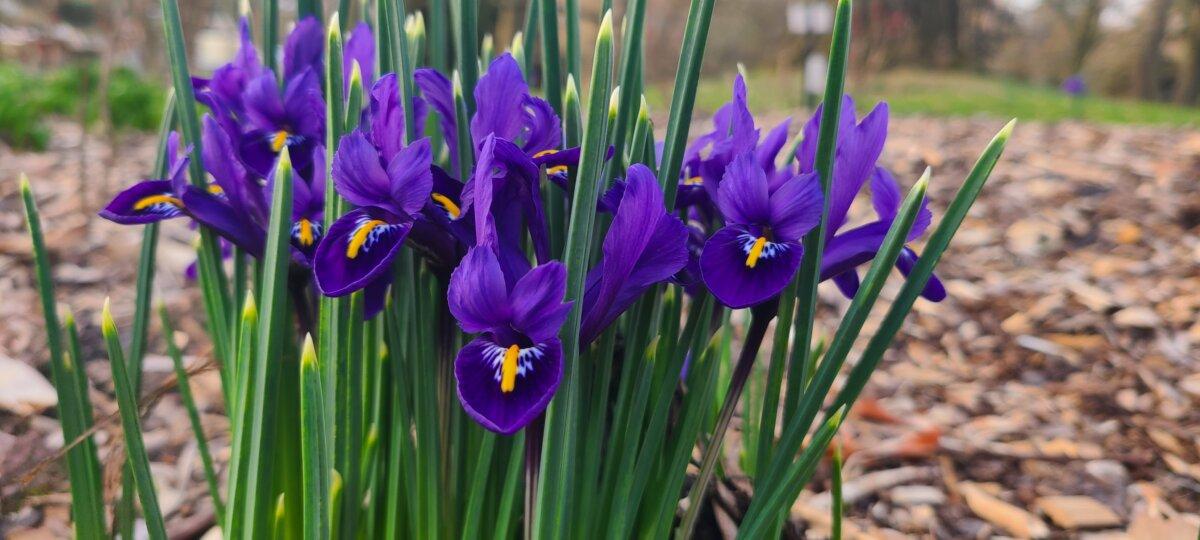
The most Outstanding Witch Hazels for your Winter Garden
If you are looking for the most outstanding Witch Hazels for your winter garden that add sweet scents and vibrant colors to dreary winter landscapes, you have come to the right place. The genus name, Hamamelis, means “together with fruit”, referring to the simultaneous occurrence of flowers with the maturing fruit from the previous year. In the following article, you will find some of my favorite witch-hazel cultivars. Many of them are cultivars of the hybrid Hamamelis x intermedia, that have been selected for use as garden shrubs. This is a cross between Hamamelis japonica and Hamamelis mollis. Two of our native witch-hazels, Hamamelis ovalis and Hamamelis virginiana, unfortunately did not make the list. However, they have their own outstanding virtues and should be considered.
Hamamelis x intermedia ‘Barmstedt Gold’




Hamamelis x intermedia ‘Barmstedt Gold’ is a deciduous shrub that belongs to the family Hamamelidaceae. It is a hybrid between Hamamelis japonica and Hamamelis mollis, both of which are native to Asia. ‘Barmstedt Gold’ is a cultivar that is prized for its vibrant golden yellow flowers that appear in the late winter or early spring, typically in February or March. The flowers are fragrant and resemble small, spidery pom-poms. The leaves of ‘Barmstedt Gold’ are oval-shaped, with serrated edges and a slightly wrinkled texture. They are green in color and turn a rich shade of yellow in the fall before dropping for the winter.
‘Barmstedt Gold’ is a relatively slow-growing shrub that can reach a height and spread of up to 4-5 meters if left unpruned. It prefers a moist, well-draining soil and partial shade to full sun exposure. It is hardy to USDA zones 5-9, making it suitable for a wide range of climates. In addition to its ornamental value, ‘Barmstedt Gold’ is also used in traditional medicine to treat a variety of ailments, including skin irritations, insect bites, and inflammation.
Hamamelis x intermedia ‘Strawberries and Cream’


Hamamelis x intermedia ‘Strawberries and Cream’ is a deciduous shrub that belongs to the family Hamamelidaceae. It is a hybrid between Hamamelis japonica and
Hamamelis mollis, both of which are native to Asia. ‘Strawberries and Cream’ is a cultivar that is prized for its showy flowers that appear in the late winter or early spring, typically in February or March. The flowers are a unique bi-color, with shades of pink and yellow that resemble strawberries and cream.
The leaves of ‘Strawberries and Cream’ are oval-shaped, with serrated edges and a slightly wrinkled texture. They are green in color and turn a rich shade of yellow in the fall before dropping for the winter. ‘Strawberries and Cream’ is a relatively slow-growing shrub that can reach a height and spread of up to 4-5 meters if left unpruned.
It prefers a moist, well-draining soil and partial shade to full sun exposure. It is hardy to USDA zones 5-9, making it suitable for a wide range of climates. In addition to its ornamental value, ‘Strawberries and Cream’ is also used in traditional medicine to treat a variety of ailments, including skin irritations, insect bites, and inflammation.
Hamamelis x intermedia ‘Angelly’


Hamamelis x intermedia ‘Angelly’ is a hybrid witch hazel cultivar, also known as vernal witch hazel or winter bloom. It is a deciduous shrub that typically grows to a height of 6-10 feet (1.8-3 meters) with a similar spread.
‘Angelly’ is known for its striking bright yellow, fragrant flowers that bloom in late winter to early spring, typically from February to March, before the leaves appear. The flowers are ribbon-shaped, with narrow, crinkled petals arranged in clusters along the branches. The foliage is a soft, green color that turns yellow in the fall.
‘Angelly’ is a relatively low-maintenance plant that prefers moist, well-drained soil and full sun to partial shade. It is tolerant of a range of soil types and pH levels and is generally pest and disease-resistant. It is a popular choice for gardeners looking to add color to their landscape during the winter months. Superior winter-flowering shrub for the landscape, shrub borders, or woodland gardens. It also makes for a good specimen.
If you really want adorn your landscape with an explosion of yellow, pair this shrub with Cornelian Cherry.
Hamamelis x intermedia ‘Chris’




Hamamelis x intermedia ‘Chris’ is a deciduous shrub, commonly known as vernal witch hazel or winter hazel. It is a hybrid of two Asian species of witch hazel, Hamamelis mollis and Hamamelis japonica. ‘Chris’ grows up to 10 feet tall and 10 feet wide at maturity, forming a broad, upright shape with arching branches.
This cultivar is known for its striking, fragrant flowers that bloom in late winter to early spring, typically from February to March, before the leaves appear. The flowers are spidery, with narrow, crinkled petals that range in color from pale yellow to deep reddish-orange.
‘Chris’ is a versatile plant that can be used in a variety of garden designs. Its broad, upright habit makes it a good choice as a specimen plant, where it can serve as a focal point in the landscape. It can also be planted in groups or massed together to create a striking display of color during the winter months.
Because of its early blooming period, ‘Chris’ is often used in garden designs to provide early-season interest and to extend the bloom period. It can be combined with other early-blooming plants such as snowdrops, crocuses, and hellebores to create a winter garden that is both colorful and fragrant.
‘Chris’ prefers moist, well-drained soil and full sun to partial shade. It is relatively low-maintenance, with few pest or disease problems. It is also tolerant of a wide range of soil types and pH levels, making it a good choice for a variety of garden settings.
Hamamelis vernalis ‘Autumn Embers’



Hamamelis vernalis ‘Autumn Embers’ is a deciduous shrub that typically grows to be about 6 to 10 feet tall and wide. It is a cultivar of the native Ozark witch-hazel, Hamamelis vernalis, and is known for its stunning fall color display.
In the autumn, the leaves of ‘Autumn Embers’ turn a brilliant orange-red, providing a striking contrast against the bare branches. The shrub produces fragrant, spidery yellow flowers in late winter or early spring, before the leaves emerge.
In the garden, ‘Autumn Embers’ can be used as a specimen plant, or planted in groups to create a colorful hedge or border. It prefers moist, well-drained soil and full to partial sun exposure. It is also tolerant of a wide range of soil types and pH levels. Pruning is not necessary, but can be done in late winter or early spring to shape the plant and remove any damaged or diseased branches.
Overall, Hamamelis vernalis ‘Autumn Embers’ is a beautiful and low-maintenance shrub that can add vibrant color to your garden in both the fall and spring seasons.
Hamamelis japonica ‘Tsukubana Kurenai’



Hamamelis japonica ‘Tsukubana Kurenai’ is a cultivar of the Japanese witch hazel that is known for its stunning, deep red flowers. Flowers open a bit later than other Witch Hazels (it is still flowering on March 1st in the garden) to reveal intense, cherry red, strap-shaped petals that are highly scented spicy fragrance. It does grow a bit slowly and takes a while to achieve its mature size of around 10ft high by 10 ft wide.
This cultivar is named after the city of Tsukuba in Japan, where it was first discovered. It is a relatively rare cultivar, and it can be difficult to find in some areas.
In terms of growth habit, Hamamelis japonica ‘Tsukubana Kurenai’ is a deciduous shrub that typically grows to be around 10-15 feet tall and wide. It has a rounded shape and a somewhat open branching habit. The leaves are dark green and have a slightly glossy texture.
Like other cultivars of Hamamelis japonica, ‘Tsukubana Kurenai’ prefers a location with partial shade and well-draining soil. It is relatively low-maintenance, and it does not require regular pruning or fertilization.
Overall, Hamamelis japonica ‘Tsukubana Kurenai’ is a beautiful and unique cultivar that can add a pop of color to a garden or landscape in late winter or early spring.



